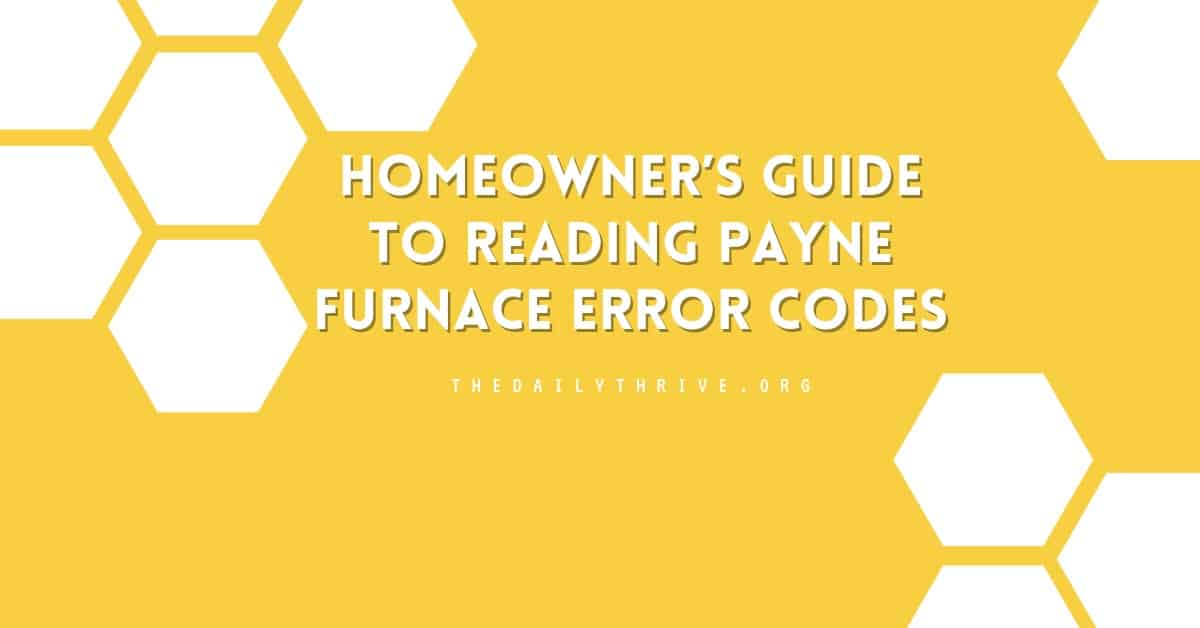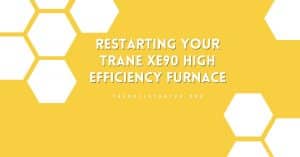Understanding how to interpret the error codes on your Payne furnace can be crucial in maintaining the efficiency and longevity of your heating system. When your furnace encounters a problem, it often uses a system of error codes to communicate the specific issue to you. These codes are typically represented by flashing LED lights on the furnace control board.
Payne furnace error codes are similar to those of Bryant and Carrier furnaces because all three brands are under the umbrella of the same parent company, United Technologies Corporation (UTC), which is now part of Raytheon Technologies after a merger in April 2020.
This shared lineage means that their furnace models often utilize the same error code systems for diagnosing issues. Understanding the error codes of one brand can, therefore, give you insights into the others, streamlining troubleshooting across these related brands. This commonality is a significant advantage for homeowners and technicians alike, as it simplifies maintenance and repairs, ensuring a more uniform and efficient approach to handling furnace problems.
Identifying Payne Furnace Error Codes
Payne furnaces are equipped with an LED light visible through a small window on the front panel. When the furnace operates normally, this light emits a steady, continuous glow. However, the LED flashes in patterns if the system encounters an issue.
These patterns are the key to understanding your furnace’s error codes. Each pattern corresponds to a specific problem, ranging from minor issues that homeowners can address to more serious malfunctions requiring professional assistance.
The error codes are typically presented as a series of short and long flashes. For instance, two short flashes followed by three long flashes might represent a different issue than three short flashes. It’s essential to observe the sequence carefully to accurately diagnose the problem.
Where can I find the Payne Furnace codes?
Locating the error code on your furnace is a crucial first step in troubleshooting any issues it might be experiencing. Modern furnaces, particularly high-efficiency models and most mid-efficiency ones are equipped with a system to display error codes. These codes, a flashing LED or digital display sequence, are on the furnace control board.
The furnace control board, the brain behind these error signals, is typically situated in the lower compartment of the furnace. You can easily spot the error code LED or digital display through a small, clear plastic inspection port located centrally on the lower furnace cover. This design ensures that homeowners and technicians can quickly check the furnace’s status without needing to open or dismantle the unit.
In some instances, particularly depending on the model and make of your furnace, the control board may be found in the upper compartment if not located in the lower one. Regardless of its position, identifying and interpreting the error codes displayed by your furnace is essential for effective maintenance and troubleshooting. This error reporting system simplifies diagnosing problems, allowing quicker, more targeted repairs that ensure your furnace operates efficiently and reliably.
Common Payne Furnace Error Codes and Their Meanings
While specific error codes can vary depending on the model of your Payne furnace, some common codes include:
Let’s break down what these codes mean for your furnace’s performance and what steps you should consider.
- RED LED1 ON: This indicates the furnace is operating in emergency heat mode, a backup operation mode used when there’s an issue with the primary heating system.
- RED LED2 ON: Signals a malfunction in the microprocessor, essentially the brain of your furnace, indicating it may need a reset or professional diagnostics.
- YELLOW LED3 ON: The furnace operates in high heat mode, suitable for colder conditions, but should switch modes according to temperature needs.
- GREEN LED4 ON: The furnace operates in low heat mode, which is ideal for maintaining temperature without excessive energy.
- RED LED2 FLASHING: This warns of reversed line voltage polarity, a potentially dangerous electrical issue requiring immediate professional attention.
Numeric codes further detail the furnace’s status and specific issues:
- Code 11 (NO FAULT IN RECENT HISTORY DISPLAY) indicates that no recent issues have been detected, showing that the system is currently running smoothly.
- Code 12 (BLOWER CALIBRATION LOCKOUT): Suggests a problem with blower calibration, potentially affecting airflow and furnace efficiency.
- Code 13 (LIMIT SWITCH LOCKOUT): This code indicates repeated triggering of the limit switch, possibly due to overheating or airflow restrictions.
- Code 14 (IGNITION LOCKOUT) indicates that the furnace failed to ignite after multiple attempts, which could be due to issues with the gas supply or igniter.
- Code 21 (INVALID MODEL SELECTION) and Code 22 (SETUP ERROR): These codes suggest issues with the furnace’s setup, possibly requiring reconfiguration or updates to the system settings.
- Code 23 (INVALID BLOWER AIRFLOW SELECTION) and Code 24 (SECONDARY VOLTAGE FUSE IS OPEN) Point to blower airflow settings and electrical problems that could impact performance.
- Code 31 (Inadequate combustion air supply—Restricted vent) indicates that the furnace isn’t receiving enough air for combustion, which could be due to blockages or issues with the venting system.
- Codes 33 (LIMIT CIRCUIT FAULT): These codes highlight a range of issues, from airflow and ignition problems to faults in the furnace’s control circuits, each requiring specific diagnostics and repairs.
- CODE: 34 – IGNITION PROVING FAILURE: This error indicates the furnace’s control system did not detect a flame when it attempted to ignite the burners. Common causes include issues with the gas supply, faulty ignition components (like igniters or flame sensors), or problems in the control board itself. Checking and cleaning the flame sensor, ensuring the gas valve is operational, and verifying the igniter’s functionality are good first steps to troubleshooting this error.
- CODE: 41 – BLOWER OUTSIDE VALID SPEED RANGE: When you encounter this error, it means the blower motor is running at a speed that doesn’t align with the furnace’s specifications. This could be due to a malfunctioning blower motor, incorrect settings, or issues with the control board’s communication with the blower. Inspecting the blower motor and verifying the settings on the control board can help resolve this issue.
- CODE: 42 – INDUCER OUTSIDE VALID SPEED RANGE: This code signals that the inducer motor, which helps expel exhaust gases, is not operating within its designated speed range. Potential culprits include a failing inducer motor, blockages in the exhaust vent, or electrical problems affecting motor speed. Cleaning blockages and assessing the inducer motor’s operation are critical steps in addressing this error.
- CODE: 43 – PRESSURE SWITCH CALIBRATION FAULT: Error code 43 indicates a discrepancy in the pressure switch calibration, preventing the furnace from verifying the correct operation of the exhaust and intake vents. This could be due to improper installation, a malfunctioning pressure switch, or vent blockages. Checking vent integrity, ensuring proper switch installation, and replacing a faulty switch are remedies for this error.
- CODE: 44 – BLOWER CALIBRATION FAULT: Similar to error 41, this code suggests an issue with the blower motor’s calibration. It might not accurately respond to the control board’s commands due to calibration errors or mechanical issues within the blower motor. Recalibrating or inspecting the motor for faults is advisable when this error occurs.
- CODE: 45 – CONTROL CIRCUITRY LOCKOUT: This severe error means the furnace’s control board has locked out the control circuitry due to repeated system failures. It’s a protective measure to prevent damage or unsafe conditions. This could stem from persistent unresolved errors, electrical issues, or a failing control board. Resetting the furnace and addressing any underlying persistent errors is necessary.
Troubleshooting Based on Error Codes
When your Payne furnace displays any of these error codes, it’s essential to take note of the specific issue and consider the best course of action. While some problems, like checking for blocked vents (Code 31) or resetting the furnace to clear a one-time ignition lockout (Code 14), can be handled by homeowners, many of these error codes indicate complex issues that require professional inspection and repair.
For instance, a certified HVAC technician should address errors related to the furnace’s microprocessor (RED LED2 ON) or electrical issues (Code 24) to ensure safe and correct repairs. Likewise, calibration errors (Codes 12 and 44) or any issues affecting the furnace’s ability to ignite properly (Code 14) underscore the importance of professional diagnostics to prevent further damage to the system or unsafe operating conditions.
Suppose the error code suggests a complex issue or you’re uncomfortable performing maintenance tasks. In that case, it’s best to call a certified HVAC technician. Attempting to repair significant problems without the proper knowledge can be dangerous. It might lead to further damage to your furnace.
Regular maintenance of your Payne furnace can prevent many common errors. This includes changing the air filter every three months, ensuring the venting system is not blocked, and scheduling annual inspections with a qualified technician. These steps can help keep your furnace running smoothly and may prevent the occurrence of error codes.
Payne furnace error codes are designed to help homeowners and technicians quickly identify and address issues within the heating system. By understanding what each code signifies, you can take prompt, informed action to ensure your furnace continues to operate safely and efficiently. Remember, when in doubt, consulting with a professional HVAC technician is always the best approach to resolving furnace issues.






